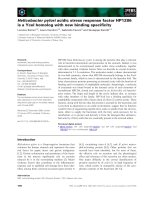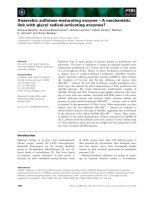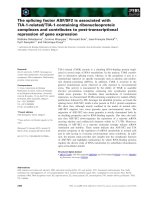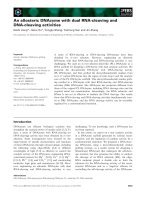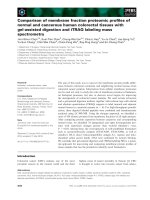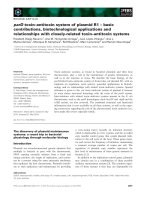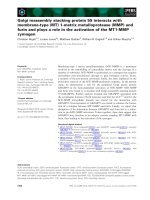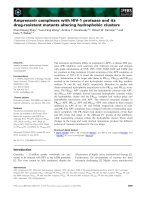Tài liệu Báo cáo khoa học: "HANDING WITH APROEUPS" docx
Bạn đang xem bản rút gọn của tài liệu. Xem và tải ngay bản đầy đủ của tài liệu tại đây (512.57 KB, 6 trang )
H~ADING WITH A PURPOSE
Michael Lebowitz
Department of Computer Science,
Yale
University
1.
iNTRODUCTION
A newspaper story about terrorism, war, politics or
football is not likely to be read in the same way as a
gothic novel, college catalog or physics textbook.
Similarly, tne process used to understand a casual
conversation is unlikely to
be
the same as the process
of understanding a biology lecture or TV situation
comedy. One of the primary differences amongst these
various types of comprehension is that the reader or
listener will nave different goals in each case. The
reasons a person nan for reading, or the goals he has
when engaging in conversation wlll nave a strong affect
on what he pays attention to, how deeply the input is
processed,
and
what information is incorporated into
memory. The
computer
model of understanding described
nere addresses the problem of
using a
reader's purpose
to assist in natural language understanding. This
program, the Integrated Partial Parser (IPP) ~s designed
to model the way people read newspaper stories in a
robust, comprehensive, manner. IPP nan
a
set of
interests, much as
a
human reader
does.
At the moment
it concentrates on stories about International violence
and
terrorism.
IPP contrasts sharply wlth many other tecnniques which
have been used in parslng. Most models of language
processing have had no purpose in reading. They pursue
all inputs with the same dillgence and create the same
type of representation for all stories. The key
difference in IPP is that it maps lexlcal input into as
high
a
level
representation as possible,
thereby
performing the complete understanding process. Other
approaches have invariably first tried to create a
preliminary representation, often
a
strictly syntactic
parse tree, in preparation for real understandlng.
~ince high-level, semantic representations are
ultimately necessary for
understanding,
there is
no
obvious
need
for creating
a
preliminary syntactic
representation, which can be
a
very difficult task. The
isolation of the lexlcal level processing from more
complete understanding processes makes it very difficult
for hlgn
level
predictions to influence
low-level
processing, which is crucial in
IPP.
One very popular technique for creating a low-level
representation of sentences
has been
the Augmented
Transition NetworX (ATN). Parsers of this sort
have
been discussed by Woods [ 11] and Kaplan [SJ. An
ATN-IiKe
parser was
developed
by
Winograd [10].
Most
ATN
parsers nave
dealt
primarily wltn syntax,
occasionally checking a" few simple semantic properties
of words. A more recent parser wnicn
does
an isolated
syntactic parse was created
by
Marcus [4].
TOe
important thing
to
note
about
all of these parsers is
that they view syntactic parsing as a process to be done
prior to
real understanding. Even
thougn systems of
this sort at times
make
use of semantic information,
they are driven by syntax. Their ~oal of developing a
syntactic
parse
tree is not
an
explicit part of the
purpcse of human understanding.
the type of understanding done by IPP is in some sense a
compromise between the very detailed understanding of
This work was supported in part by the Advanced Research
8roJects A~enoy of the Department of Defense and
monitored under the Office of Naval Research under
contract N00014-75-C-1111.
SAM Ill and P~M [9], both of which operated in
conjunction with ELI, Riesbeck's parser [SJ, and the
skimming,
highly
top-down, style of
FRUMP
[2].
EL1
was
a semantically driven parser which maps English language
sentences into
the
Conceptual Dependency [6]
representations of their meanings, it made extensive
use of the semantic properties of the words being
processed, but interacted only slightly with the rest of
the understanding processes it was a part of. it would
pass off a completed Conceptual Dependency
representation of each sentence to SAM or PAM which
would try to incorporate it into an overall story
representation. BOth these programs attempted to
understand each sentence fully, SAM in terms of scripts,
PAM in terms of plans and goals, before going onto the
next sentence. (In [~] Scnank and Abelson describe
scripts, plans and goals.) SAM and PAM model the way
people might read a story if they were expecting a
detalied
test on it, or the
way a textbook might be
read. £acn program's purpose was to get out of a story
every piece of informatlon possible, fney treated each
piece of every story as being equally important, ~nd
requiring total understanding. Both of these programs
are relatively fragile, requiring compiex dictionary
entries for every word they might en0ounter, as well as
extensive
Knowledge
of
the
appropriate scripts
and
plans.
FRÙMP, in contrast to SAM and rAM, is a robust system
whlcn attempts to extract the amount of information from
a newspaper story which a person gets when ne skims
rapidly. It does this
by
selecting a script to
represent the story and then trying to fill in the
various slots which
are
important to understand
the
story. Its purpose is simply to obtain enough
information from a story to produce a meaningful
summary. FRUMP is strongly top-down, and worries about
incoming information from the story only insofar ~s it
helps fill In the details of the script which it
selected. 50 wnile FRUMP is robust, simply skipping
over words it doesn't Know, it does miss interesting
sections of stories which
are
not explained by its
initial selection of
a
script.
18P attempts to model the way people normally read a
newspaper story. Unlike SAM and PAH, it does not care
if it gets every last plece of information out of a
story. Dull, mundane information is gladly ignored.
But, In contrast with FRUMP, it does not want to miss
interesting parts of stories simply because tney do not
mesh with initial expectations. It tries to create a
representation which captures the important aspects of
each story,
but
also tries to minimize extensive,
unnecessary processing which does not contrlbute to the
understanding of the story.
Thus IFP's purpose is to decide wnat parts of a story,
if any, are interesting (in IPP's case, that means
related to terrorism), and incorporate the appropriate
information into its memory. The concepts used to
determine what is interesting are an extension of ideas
presented by SctmnK [7].
2. How l~ EOA~s
The ultimate purpose of reading a newspaper story is
to
incorporate new information into memory. In order
to
do
this, a number of different Kinds of Knowledge are
needed. The understander must Know the meanings of
words, llngulatic rules about now words combine into
sentences, the conventions
used
in writing newspaper
5g
stories, and, crucially, have extensive knowledge about
the "real world." It is impossible to properly
understand a story without applying already existing
knowledge about the functioning of the world. This
means the use of long-term memory cannot be fruitfully
separated from other aspects of the natural
understandin~ problem. The mana~emant of all this
information by an understander is a critical problem In
comprehension, since the application of all potentially
relevant Knowledge all the time, would seriously degrade
the understandin~ process, possibly
to
the point of
halting It altogether. In our model of understanding,
the role played by the interests
of
the understander Is
to allow detailed processing to occur only on the parts
of
the story which are Important to overall
understanding, thereby conserving processing resources.
Central to any understandin~ system is the type of
Knowledge structure used to represent stories. At the
present time,
IPP
represents stories in terms of scripts
similar
to, although
simpler than, those
used
by
SAM and
FRUMP.
Most of the co on events In
IPP's
area of
Interest, terrorism, such as hiJaokings, kidnappings,
and ambushes, are reasonanly stereotyped, although not
necessarily wltn
all the temporal sequencing present in
the scripts SAM uses. ZPP also represents some events
directly In Conceptual Dependency.
The
representations
in IPP consist of two types of structures. There are
the event structures themselves, generally scripts such
as
$KIDNAP and SAMBUSH, which form the backbone of the
story representations, and tokens which fill the roles
in
the event
structures. These
tokens are
basically
the
?tcture Producers of [6], and represent the concepts
underlying words such as "airliner," "machine-gun" and
"Kidnapper." The final story representation can also
Include links between event structures indicating
causal, temporal and script-scene relationships.
Due to IPP's limited repertoire of structures with which
to represent events, it is currently unable to fully
understand some stories which maXe sense only in terms
of goals and plans,
or
other higher level
representations. However, the understanding techniques
used
in IPP
should be
applicable to
stories
which
require the use of such knowledge structures. This is a
topic of current research.
It Is worth noting that the form of a story's
representation may depend on the purpose behind its
being read. If the reader is only mildly Interested in
the subject of the story, soriptal representation may
well be adequate. On the other hand, for an story of
great interest to the reader, additional effort
may
be
expended to allow the goals and plans of the actors In
the story to be gorked out. This Is generally more
complex than simply representing a
story
in terms of
stereotypical knowledge, and will
only
be attempted in
cases of great interest.
In order to achieve its purpose, ~PP does extensive
"top-down" processing. That Is, It makes predlotions
aOout what it is likely to see. These predictions range
from low-level, syntactic predictions ("the next noun
phrase will be the person kidnapped," for instance) to
quite high-level, global predictions, ("expect to see
demands made by the terrorist"). Significantly, the
program only makes predictions about things it would
like to Know. It doesn't mind skipping over unimportant
parts of
the
text.
The top-down predictions made by IPP are implemented in
terms of requests, similar to those used by RiesbecK
[5], which are basically Just test-action pairs. While
such an implementation In theory allows arbitrary
computations to ~e performed, the actions used in IPP
are in fact quite limited. IPP requests can build an
event structure, link event structures together, use a
token to fill a role in an event structure, activate new
requests
or
de-activate
other
active
requests.
The tests in IPP requests are also llmited in nature.
They can look for certain types of events or tokens,
check for words with a specified property in their
dictionary entry, or even check
for
specific lexical
items. The tests for lexical items are quite Important
in Keeping IPP's processing efficient. One advantage is
that very specific top-down predictions will often allow
an otherwise very complex word disa~biguation process to
be bypassed. For example, in a story about a hijacking,
ZPP expects the word "carrying" to indicate that the
passengers of the hijacked vehicle are to follow. So it
never has to consider An any detail the meaning of
"carrying." Many function words really nave no meaning
by themselves, and the type of predictive processing
used by IPP is crucial in handling them efficiently.
Despite its top-down orientation, IPP does not ignore
unexpected Input.
Rather, If the new Information is
interesting in itself the program will concentrate on
it, makin~ new predictions In addition to, or instead
of, the original ones. The proper integration of
top-down and bottom-up processing allows the program to
be efficient, and yet not miss interesting, unexpected
information.
The bottom-up processin~ of IPP is based around a
ulassification of words that is done strictly on the
basis
of
processing considerations.
IPP
Is interested
in the traditional syntactic classifications only when
they help determine how worqs should be processed.
IPP's criteria for classification Involve the type of
data structures words build, and when they should be
processed.
Words can build either of the main data structures used
in XPP, events and tokens. The words bulldin~ events
are usually verbs, but many syntactic nouns, such as
• kidnapping," "riot," and "demonstration" also indicate
events, and are handled in Just the same way as
traditional verbs. Some words, such as =oat adjectives
and adverbs, do not build structures but rather modify
structures built by other words. These words are
handled according to the type of structure they modify.
The second criteria for classifying words - when they
should be processed - is crucial to 1PP's operation. In
order to model a rapid, normally paced reader, IPP
attempts to avoid doin~ any processing which will not
add to its overall understandin~ of a story. To do
this, it classifies words into three groups -
words
which must be fully processed i edlately, words which
should be saved in short-ter~ memory, and then processed
later, if ne,=essary, and words which should be skipped
entirely.
Words which must be processed immediately include
interesting words building either event structures or
tokens. "Gunmen," "kidnapped" and "exploded" are
typical examples. These words give us the overall
framework of a story, indicate how much effort should 0e
devoted to further analysis, and, most importantly,
generate the predictions w~loh allow later processing to
proceed
efficiently.
The save and process later words are those which may
become si~nifioant later, but are not obviously
impor~cant when they are read. This class is quite
substantial, Including many dull nouns and nearly all
adjectives and adverbs. Zn a noun phrase sucn as
"numerous Italian gunmen," there Is no point in
processing tO any depth "numerous" or "Italian" until we
~now the word they modify
is
Important enou~n to be
included in the final representation. Zn the cases
where further procesein~ is necessary, IPP has the
proper information to easily incorporate the saved words
Into the story representation, and In the many cases
60
where the word is not important, no effort above
saving
the word is
required.
The
processin~ strategy for these
words is a Key to modei~n~ nom,al reading.
The final class
of words are
those IPP skips
altogether.
Thls class includes very unlnterestln~ words whlch
neither
contribute
processing clues, nor
add
to the
story
representation. Many
function words,
adjectives
and
verbs irrelevant to the
domain
at hand,
and
most
pronouns
fall
into this category.
These
words
can
still
be significant in cases where they are predlcted, but
otherwise they are ignored by IPP and take no processln~
effort.
In addition to the processing techniques mentioned so
far, IPP makes use of several very pragmatic heuristics.
These are particularly important in processlng noun
~roups properly. An example of the type of heuristic
used is IPP's assumption that the first actor in a story
tends to be important, and is worth extra processing
effort. Other heurlst~cs can be seen in the example In
section
~.
IP~'s basic strategy is to make reasonable
guesses about the appropriate representation as qulcKly
as possible, facilitating later processln~ and
fix
things later if its ~uesses are prove to be wrong.
~. ~
DETAILED ~XAMPLE
~n
order to illustrate bow IPP operates, and how its
purpose affects its process|n{, an annotated run of IPP
on a typical story, one taken from the Boston Globe is
shown below.
The
text between the rows of stars has
been added to explain the operation of IPP. Items
beginning
with
a
dollar sign, such
as
$rERRORISM,
indicate scripts used by IPP to represent
events.
[PHOTO: Initiated Sun 24-Jun-79 3:36PM]
@RUN IPP
*(PARSE $1)
Input:
$1
(3 I~ 79) IRELAND
(GUNMEN FIRING FROM AMBUSH SERIOUSLY WOUNDED AN
8-YEAR-OLD
GIRL
AS
SHE
WAS
BEING TAKEN TO
SCHOOL
YESTERDAY AT STEWARrSTOWN COUNTY
r~RONNE)
Processing:
GUNMEN
: InterestinE token - GUNMEN
Predictions
- SHOOTING-WILL-OCCUR ROBBERY-SCRIPT
TERRORISM-SCRIPT HIJACKING-SCRIPT
lll**lem*llllll*l*mli,lll,l,lll,l,mllll,mlm,lllilmm,illl
GUNMEN is marked In the dlotionary as inherently
interesting. In humans this presumably occurs after a
reader
has noted that
stories
involving gunmen tend to
be interesting. Since it is interesting, IPP fully
processes GUNMEN, Knowing that it Is important to its
purpose of extracting
the
significant content of the
story, it builds a token to represent the GUNMEN and
makes several predlctlons to facilitate later
processing. There is a strong possibility that some
verb conceptually equivalent to "shoot" will appear.
There are also a set of scripts,
including
SROBBERY,
STERRORISM and $HIJACK wnlcn are likely to appear, so
IPP creates predictions looking for clues indicating
that one of these scripts sOould be activated and used
to represent the story.
FIRING
: Word satisfies prediction
Prediction confirmed - SHOOTING-WILL-OCCUR
Instantiated
$SHOOT script
61
Predictions ° $SHOOf-HUL::-FINUER REASON-FOR-SHOOtING
$SHoor-scEN~S
tJeiIJ~i~Jf~mmQll~l|l#~Oilm~i~Ome|J|i~|~i~iQltllliJIDI
FIHING satisfies the predlction for a "shoot" verb.
Notice that tne prediction immediately dlsamblguates
FIRING. Other senses of the word, such as "terminate
employment" are never considered. Once IPP has
confirmed an event, it builds a structure to represent
it, in this case the
$SHOOr
script and the token for
GUNMEN is filled in ss the actor. Predictions are made
trying to flnd the unknown roles of the script, VICTIM,
in
particular, the reason for the shooting, and
any
scenes of $SHOOT wnicn might be found.
JJJiJJJJJiJiJJJJJJJJJJJJJJJJJJJJJJJJJJJJJJlJJJJJJJJJJJJJ
instantiated $ATTACK-P~RSON script
Predictions - SAT rACK-PERSON-ROLE-FINDER.
SATrACK-PERSON-SC~N~S
Im,*|i@m|li,I@Wm~#mI~@Igm#wIiII#mmimmIII|@milIIillJgimR@
IPP does not consider the
$SHOOT
script to be a total
explanation
of
a snootin~ event. It
requires
a
representation wnlcn indicates the purpose of the
various actors, in the absence of any other
information,
IPP
assu~es people wno shoot are
deliberately attacKin~ someone. So the SATTACK-PERSON
script is Inferred, and $SHOOT attacned to it as a
scene. The SATTACK-PERSON representation allows IPP to
make inferences which are relevant to any case of a
person being attacked,
not
just snootin~s. IPP is still
not able to Instantiate any of the
high
level scripts
predicted by GUNMEN, since the SATTACK-PERSON script is
associated with several of the~.
FROM : Function word
Predictions - FILL-FROM-SLOT
Ji*JiJJeJ**JJJJiJJJJJJJlJJJJJJJJJ*JJJJ*JJJJ**J*JJJJJ*J*J
FROM in s =ontext such as this normally indicates the
location from which the attack was made is to follow, so
IPP makes a prediction to that effect. However, since a
word building a token does not follow, the prediction is
deactivated. The fact that AMBUSH is syntactically a
noun is not relevant, since iFP's prediction loo~s for a
word which identifies a place.
li*JiJJ*Jll**J*lJli|iJl*lii|llll#*J**JiJJiJJ**iJil*iiJJ*
AMBUSH
: Scene word
Predictions - SAMBUSH-ROL~-FIND~R $AMBUSH-SCENKS
Prediction confirmed - TERRORISM-SCRIPT
Instantlated $TERRORISM script
Predictions - TERRORIST-DEMANDS STERRORISM-ROLE-FINDER
STERRORISM-SCENES COUNTER-MEASURES
J*lJJJ*JiJJJJJJiJ*JJJJJJlJJJJJJJJJ*JJJi*JJ*JJJJ***JJJJ**
IPP
<nows
the word AMBUSH to
indicate
an
instance of the
SAMBUSH scr|pt, and tn~t SAMBUSH can be a scene of
$TERRORISM (i.e. it is an activity w~Ich can be
construed as a terrorist act). This causes the
prediction made by
GUNMEN
that
$TERRORISM was a
possible
script tO be trlggerred. Even if AMBUSH had other
meanings, or could be associated with other higher level
scripts, the prediction would enable quicK, accurate
identification
and
incorporation of the word's meaning
into the story representation. IPP's purpose of
associating the shooting with a nlgh level Knowledge
structure which helps to expialn it, has been achieved.
At this
point
in the processing an Instance of
STERRORISM is constructed to serve
as
the top level
representation
of
the story.
The
SAMBUSH and
SATTACK-PERSON scripts are attached as scenes
of
STERRORISM.
SgRIOUSLY
:
SKip and save
~OUNO£D :
Word satisfies prediction
Prediction confirmed - SWOUND-SCENE
Predictions -
SWOUND-ROLE-FINDER SWOUND-SCENES
t~e~eoeeeleleeeeeeelloeelem|eee|eoeeeeaoalenlo|eleeoeeee
SWOUND is a Known scene of $ATTACK-PERSON,
representin~
a common outcome of an attack. It is instantlated and
attached to $ATTACK-P~RSON. IPP infers that the actor
of SWOUND
is
probably the
same as
for $A~ACK-PERSON,
i.e. the GUNMgN.
eleileleleeeelllllll|lllalllolsllieilllOlllelllel|oileil
AN : SKip and save
~-YEAR-OLD : Skip and save
GiRL : Normal token - GIRL
Prediction confirmed -
SWOUND-ROLE-FINDER-VICTIM
eeee~eeeeeeme~eee~see~e~eee~m~ee~o~eeeeeeeeeee~aeeoee
~IRL Ouilds
a toXen
wnlch fllls t~e VICTIM role
of
the
SWOUND script. Since IPP has inferred that the VICTIM
of the ~ATrACK-PERSON and
SSHOOr
scripts are the same as
the VICTIM of SWOUND, it also fills in those roles.
Identifyin~ these roles is integral to IFP's purpose of
understanding
the
story, since
an attack on a person can
only Oe properly understood
if
the
victim is
Known. As
t~is person
is
important to
the understandln~
of
the
story, IPP wants to acquire as much information as
possible
about net. Therefore,
it
looks baoK
at
the
modifiers temporarily saved in short-term memory,
8-YEAR-OLD in this case,
and
uses
them
to modify
the
token ~uilt for GIRL. The age of the ~Irl is noted as
eight years. This information could easily be crucial
to
appreciatin~ the interesting nature
of
the story.
@EeE~eeBe@~oeeEeeeeeeeE~e~aEeeoaeEsasee|eaeeeeeeeeEssee
AS : SKip
SHE : SKip
WAS : SKip and save
BEING : Dull verb - skipped
TAKEN : SKip
TO : Function word
SCHOOL
:
Normal
token - SCHOOL
Y~ST~RDAY : Normal token - YESTERDAY
~eee~ene~e~e~neeeeeaeeeeoeeeeeeeaeeeeeaeeeeeeeeeeeeeeee
Nothin~ in this phrase is either inherently interesting
or fulfills
expectations made earlier in the processing
of
the
story. So it is all prc,:essed
very
superficially, addin~
nothing to
the final
representation. It is important that IPP ma~es no
attempt
to dlsamOi~uate words such as TAKEN, an
extremely complex process, since
it
knows none of the
possible
meanings
will add significantly
to
its
understanding.
@illIIIIIIIIIIIIIIIIIIIIIIIllOIIlllIIIIIiilIIIIIIIIilIII
AT
:
Function word
STEWARTSTOWN : Skip and save
COUNTY
:
SKip and save
TYRONNE : Normal token - TYRONNE
Prediction confirmed - $T~RRORISH-ROLE-FIHDER-PLACE
emmtu~u~eeeeteHeJ~eee~t~e~eeeeatteet~aaeaaeaeeesewaa
ST£WARTSTOWN COUNTY rYRONNE satisfies the ?redlotlon for
the place where the terrorism took plane. IPP has
inferred that all the scenes of the event took place at
the same location. IPP expends effort in identifying
this role, as location is crucial to the understandln~
of most storles. It is also important in
the
or~anizatlon of memories
about
stories. A
incidence
of
terrorism
in
Northern ireland is understood differently
from one in New York or Geneva.
62
Story Representation:
ee MAIN [VENT ee
SCRIPT
$TERRORISM
ACTOR GUNMEN
PLACE $TEWARTSTOWN COUNTY TYRONNE
TIHE ~ESTERDAY
SCENES
SCRIPT
SAHBUSH
ACTOR GUNMEN
SCRIPT
$ATTACK-PERSON
ACTOR GUNMEN
VICTIM
8 ~EAR OLD GIRL
SCENES
SCRIPT
$SHOOT
ACTOR GUNMEN
VICTIM 8 XEAR OLD GIRL
SCRIPT SWOUND
ACTOR GUNMEN
VICTIM 8 YEAR OLD GIRL
EXTENT GREATERTHAN-nNORH e
saesaeeeaeeeeseeeeeeeeeesseeesesesaeaeeoeeeeaeeeeeaeeeee
IPP's final representation indicates that it has
fulfilled its purpose in readimi the story. It has
extracted roughly the same information as a person
reading the story quickly. IPP has r~ognised an
instance of terrorism oonststln8 of an ambush in whioh
an eight year-old girl was wounded. That seems to be
about all a person would normally remember from suoha
story.
eseeeeeeeeeae|eeeeeeesneeeeeaeeeeeeeeeeseeeeeeeaeeeeeese
[PHOTO: Terminated Sun 24-jun-79 3:38~]
As it pro~esses a story such as this one, IPF keeps
track of how interesting it feels the story is. Novelty
and relevance tend to increase interestlngness, while
redundancy and irrelevance dec?ease it. For example, in
the story shown moore, the faot that the
victim
of the
shooting was an 8 year-old ingresses the interest of the
story, and the the incident taMin~ place in Northern
Ireland as opposed to a more unusual sate for terrorism
decreases the interest. The story's interest Is used to
determine how much effort should be expended in tryin~
to fill in more details of t~e story. If the level of
lnterestingness decreases fax' enough, the program can
stop processing the story, and look
for a more
interesting one, in the same way a person does when
reading through a newspaper.
~. ANOTHER EXAMPLE
The following example further illustrates the
capabilities of IPP. In this example only IPP's final
story
representation
is snows. This story was also
taken from the Boston Globe.
[PHOTO: Initiated Wed 27-Jun-79 I:OOPM]
@RUN IPP
°(PARSE
S2)
Input: S2 (6 3 79) GUATEMA~t
(THE SON OF FORMER PRESIDENT EUGENIC KJELL LAUGERUD
WAS SHOT DEAD B~ UNIDENTIFIED ASSAILANTS LAST WEEK
AND A BOMB EXPLODED AT THE HOME OF A GOVERNMENT
OFFICIAL ~LICE SAID)
Story Representation:
am
MAIN EVENF
ea
SCRIPT STERRORISM
ACTOR
UNKNOWN
ASSAILANTS
SCENES
SCRIPT
$ATTACK-PERSON
ACTOR
UNKNOWN
ASSAILANTS
VICTIM SON
OF
PREVIOUS PRESIDENT
EUGENIC KJELL LAUG~RUD
SCENES
SCRIPT
$SHOOT
ACTOR UNKNOWN
ASSAILANTS
VICTIM
SON OF
PREVIOUS PRESIDENT
EUGENIC KJELL LAUGERUD
SCRIPT SKill
ACTOR
UNKNOWN ASSAILANTS
VICTIM SON OF PREVIOUS PRESIDENT
EUGENIC
KJELh
LAUG~RUD
SCRIPT
SATTACK-PLAC£
ACTOR
UNKNOWN ASSAILANTS
PLACE
HOME OF
GOVERNMENT
OFFICIAL
SC~NdS
SCRIPT $BOHB
ACTOR
UNKNONN
ASSAILANTS
PLACE HOME OF GOVERNMENT OFFICIAL
[PHOTO:
Terminated - Wed 27-Jun-79 I:09PM]
Thls example maces several interesting points about the
way IPP
operates. Notice
that 1PP has
jumped to
a
conclusion about the story,, which, while plausible,
could easily be wrong, it assumes that the actor of the
SBOMB
and
SATTACK-PLACE scripts is
the
same as
the
actor
of the STERRORISM script, which was in turn inferred
from the actor of the sbootln~ incident. Tnls is
plausible, as normally news stories are
about a
coherent
set of events witn lo~Ical relations amongst them. So
it is reasonable for
a story
to De
about a
series of
related
acts
of terrorism, committed
by
the same person
or
~roup, and
tnat is what
IPP
assumes here
even
though
that may not be correct. Uut this ~Ind of inference is
exactly
the
Kind which IPP
must
make
in order to
do
efficient top-down processln~, despite the possibility
of errors.
The
otner interesting point about tnis example is the
way
some of iPP's quite pragmatic heuristics for
processln~ give positive results. For instance, as
mentioned earlier, the first actor mentioned has a
stronz tendency to be important to the understandln~ of
a story. In thls story that means that the modlfyin~
prepositional phrase "of former President Su~enlo Kjell
Lau~erud"
is analyzed
and
attached to the token built
for "son,"
usually
not
an
interesting word. Heur~stlcs
of this sort ~ive IPP its power
and
robustness, rather
than
any
single rule
about
language understandln~.
5. CONCLUSION
IPP
has
been
implemented
on
a DECsystem
20/50
at
Yale.
It currently has a vocabulary of more than I~00 words
wnlcn is oelng continually Increased in an attempt to
make the program
an
expert underst~der of newspaper
stories scout terrorism. £t is also planned to
add
information about nigher
level
knowledge
structures such
as ~oals
and
plans and
expand IPP's domain of
interest.
To date, IPP has successfully processed over 50 stories
taken directly from various newspapers, many sight
unseen.
The difference between the powers of IPP and the
syntactlcally driven parsers mentioned earller can cent
be seen by the Kinds of sentences they handle.
Syntax-0ased parsers generally deal with relatively
simple, syntactically well-formed sentences. IPP
handles sucn sentences, Out also accurately processes
stories taken directly from newspapers, which
often
involve extremely convoluted syntax, and in many cases
are not grammatical at all. Sentences of this type are
difficult, if not impossible for parsers relyln~ on
syntax. IPP is
sole
to process news stories quickly, on
the order of 2 CPU seconds, and when done, it has
achieved
a
complete understandln~ of the story, not Just
a syntactic parse.
As shown in tne examples above, interest can provide a
purpose for reading newspaper stories.
In
other
situations, other factors might provide the purpose.
But the purpose is never simply to create a
representation - especially a representation
with
no
semantic content, such as a syntax tree. This is not to
say syntax is not important, obviously in many
circumstances it provides crucial information, but it
should not drive the understanding process. Preliminary
representations are needed only if they assist in the
reader's
ultimate purpose
bulldln~
an
appropriate,
high-level representation which can be incorporated with
already existing Knowledge. The results achieved by IPP
indicate that parsing directly into high-level
knowledge
structures is possible, and in many situations may well
be more practical than first doin~ a low-level parse.
Its integrated approacn allows IPP to make use of all
the various kinds of knowledge which people use when
understandtn~
a story.
References
[1]
Cullin&ford, R. (1978) Script
application:
Computer understanding of newspaper stories.
Research Report 116, Department of Computer
Science, Yale University.
[2] DeJon~, G.F. (19/9) Skimming
stories
in real
time: An experiment in integrated understanding.
Research Report 158, Department of Computer
Science, Yale University.
[3] Kaplan, R.M. (1975) On process models for
sentence analysis, in D.A. Norman and
D. E. R~elhart, ads.,
Explorations in ~oanition.
W. H. Freeman and Company, San Francisco.
[~] Marcus, M.P. (1979) A Theory of Syntactic
Recognition
for
Natural Language, in P H
.
Winston and R.H. Brown (eds.), Artificial
IntellJ~ence: an ,~ Presnectlve, HIT Press,
Cambridge, Massachusetts.
[5] Riesbeck, C. K. (1975) Conceptual analysis. In
R.C. ScnanK (ed.),. ~ Information
Processing. North
Holland,
Amsterdam.
[6]
Scnank, R.C. (1975) Conceotual Information
Processln¢. North Holland, Amsterdam.
[7] Scnank, R. C. (1978) Interestlngness: Controlling
inferences. Research Report I~5, Department of
Computer Science, Yale University.
[8] Scbank, R. C. and Abelson, R. P. (1977) Scrints.
Plans,
Goals and Understanding. Lawrence grlbaum
Associates,
Rlllsdale,
New
Jersey.
[9] dllensky,
R.
(1978)
Understanding goal-based
stories. Research Report I~0, Department of
Computer Science, Yale University.
[10] Wtnograd, T. (1972) Understandin~ Natural
Lan:uafe. Academic Press, New York.
[11] ~oods,
W. A.
(1970)
Transition
network
grammars
for natural language analysis. ~of
the ACH. Vol. 13, p 591.
63


